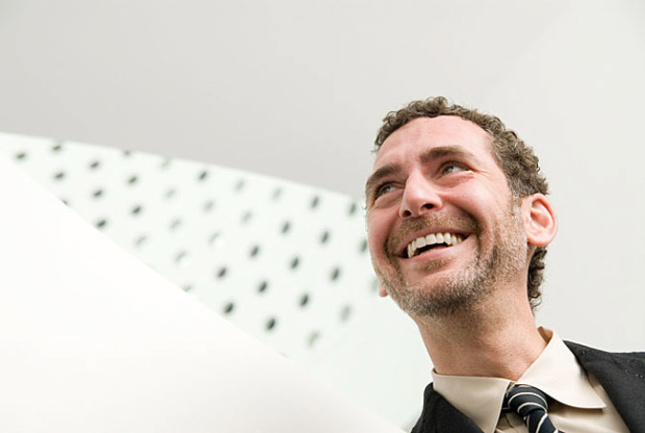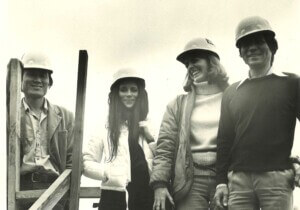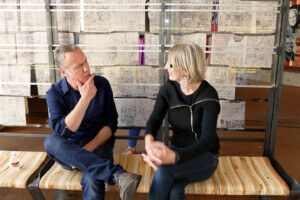Henry Urbach was a born curator. He had an eye for good design; the intellectual heft to be able to judge what was not only beautiful but also meaningful or critical to both the discipline of architecture and wider society; and the gift of gab with which to articulate all of that. He was also able to put together some of the best exhibitions on architecture of the last few decades. He was a bit of a rebel and a doubter of received notions and authority, which stood him in good stead as he developed ideas through his chosen medium of collecting and showing work in and around architecture, but which often made it difficult for him to operate within larger institutional structures. His untimely death in Tel Aviv deprives us of one of the discipline’s most distinctive talents.
With two degrees from Princeton and one from Columbia, as well as a network that reached around the globe, Urbach was able to position himself during the end of the last century as New York’s primary broker of speculative architecture. He achieved that position through the work he did at his New York gallery, Henry Urbach Architecture. Picking up where the only other gallerist to have entered the field, Max Protetch, left off, Urbach assembled a stable of young designers and artists who extended the definitions of architecture. These included not only experimental architects and practices, such as LOT-EK, François Roche, An Te Liu, Lebbeus Woods, and Jürgen Mayer H., but also many artists playing with the forms and conventions of architecture, as well as photographers who both documented and penetrated our worlds.
What Urbach showed in his Chelsea gallery, tucked up into an upper level of a warehouse on 26th Street, helped to change our perception of space and place. Much of his work focused on questions of seeing and being seen, spectacle, and the intimate relation between the body and the buildings that housed or enclosed it. He worked on issues related to queer space, and his exhibitions often had a sense of the uncanny and the slightly illicit or forbidden. They burrowed into the hidden places of the city and opened up almost operatic panoramas of what the urban scene made possible.
When I was the curator of architecture, design, and digital projects at the San Francisco Museum of Modern Art (SFMOMA) in the late 1990s, I was one of Urbach’s most eager clients. I found in his gallery a treasure trove of what I thought was some of the most important architecture and design work being done at the time, and quite a few of his pieces made it into my own exhibitions, as well as into the museum’s collection. When I moved on to direct the Netherlands Architecture Institute in Rotterdam, I invited him there to curate an exhibition on the relationship between architecture and the body. When Urbach was later appointed to my old position at SFMOMA after Joe Rosa vacated it and left for Chicago, I felt that it was a perfect choice.
Urbach organized excellent exhibitions and collected important work at SFMOMA, but, in the end, clashed with the museum’s rather conservative culture. He then moved on to direct Philip Johnson’s Glass House and do more good work there, but by then, the mark of what now appears to have been late-onset bipolar disorder turned his rebellious spirit and inquisitive mind toward swings between increasing paranoia and irrational exuberance. He moved to Israel and seemed to have found a new community and purpose as an effective and much-loved teacher, but the demons that had come to haunt him (as we like to think of such diseases) ultimately got the better of him.

It is a tribute to his family and friends that they have felt it important to let us all know, in their statement about his death, about his disease. There is a difference between having a different perspective, wanting to challenge accepted notions, and seeing the potential of what is not valued or condoned and having a medical condition that skews not only your views but also your relations with other human beings. At some point, Urbach’s ability to discern what few of us could or even wanted to see, often at the heart of our chosen avocation or in the environments we loved, and to pick, highlight, and explain such work, turned into something else, something that undercut his ability to use his great talents to move architecture toward productive confrontations.
I admit to being one of those who found it impossible, in later years, to engage in what I considered normal interactions with Urbach. Not recognizing his condition, I felt alienated and confused by his ideas and modes of interaction. I am sorry that I did not work through such difficulties, as now I will never be able to do so. What is more important is that we have lost an important life, a great spirit, and an agitator for experimental architecture. For all these reasons, we will miss Henry Urbach.
Aaron Betsky is the president of the School of Architecture at Taliesin and is the author of numerous books, including Making It Modern and Architecture Matters.











